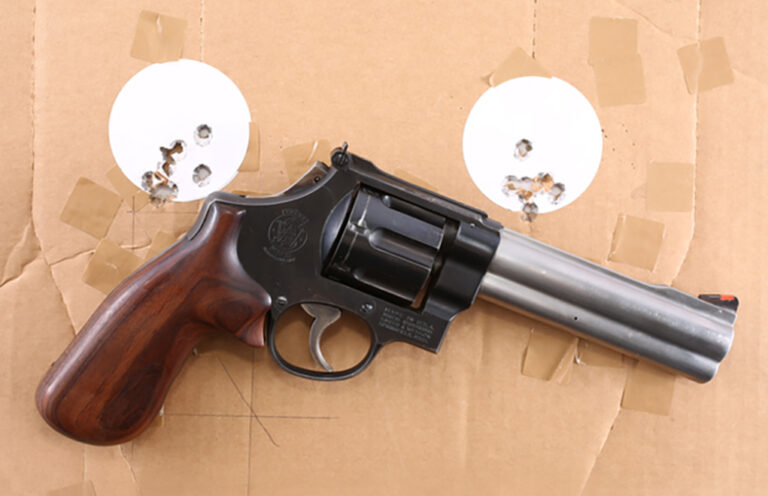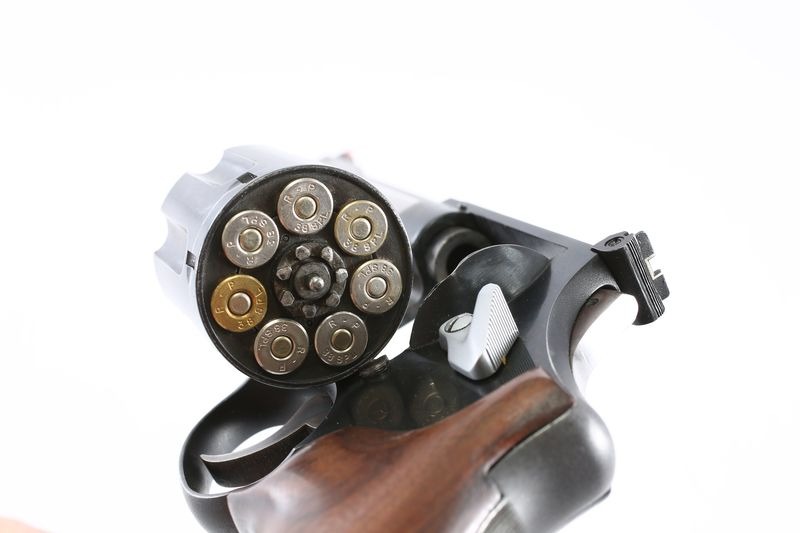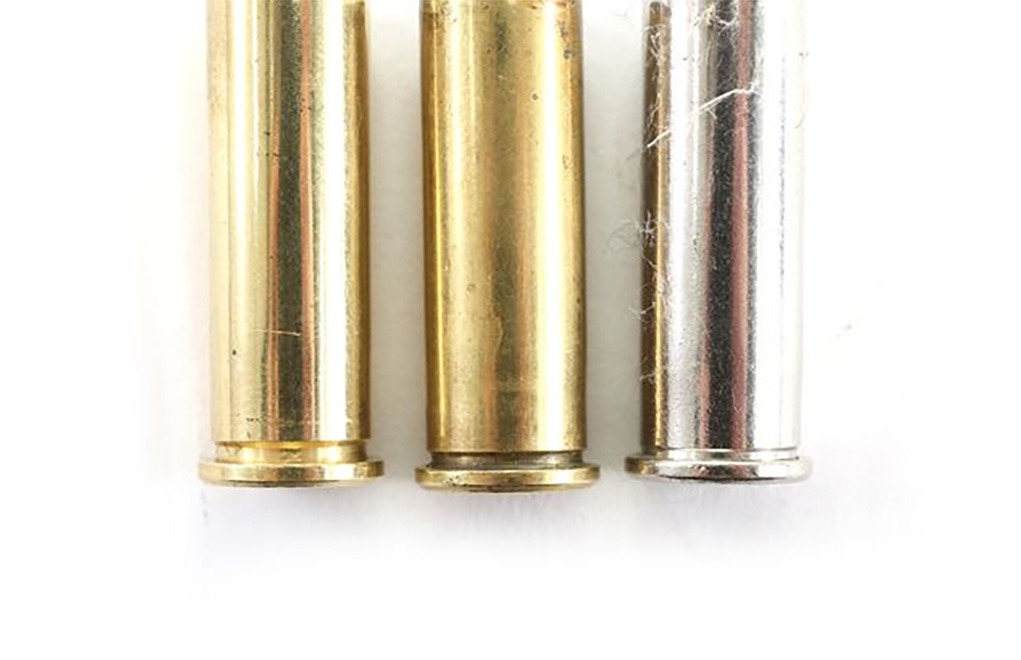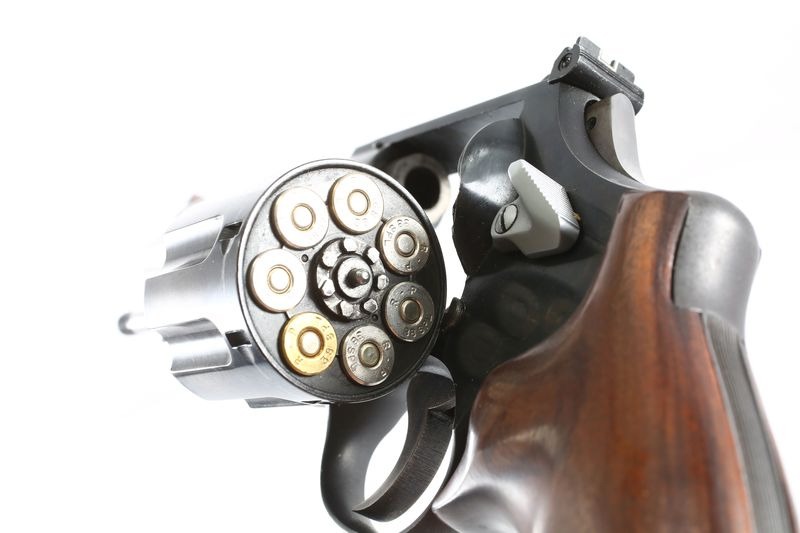
We go over a custom Smith & Wesson Model 28 revolver built for ICORE. She ain’t pretty, but she can still shoot.
For a guy who got to be known as a 1911 shooter, I spent a lot of time shooting revolvers. One wheelgun in particular was both a process and a tool. Back when the USPSA was being formed, my club was already shooting in many equipment divisions—one of which was “Revolver.” So, I had a 6-inch S&W M-25-2 in .45 ACP that I had to build … well, just to have one. (We can showcase that revolver at a later time.)
Soon after that, the International Confederation of Revolver Enthusiasts (ICORE) was formed. ICORE wasn’t interested in making Major, so I didn’t need a .45 revolver to compete there. I tried a number of different—not entirely suited to ICORE—revolvers, but I finally scored a police trade-in M-28. This is a .357 Magnum built on the N-frame, which is the .44 frame, with a matte finish for police duty. I think I picked it up for $125 back in the Reagan era.

Soon after, I won a Baumann conversion cylinder at the old Second Chance Combat Shoot. This was a seven-shot cylinder that simply plugged into a .357 Magnum N-frame revolver. It used proprietary moon clips, and it was just the thing for ICORE.
The scoring system in ICORE is simple, and it’s the same as IDPA: Your shooting time, with added time for hits outside of the center ring and any penalties, is your score. The fastest time wins. And the power factor (PF) you had to meet back then was only 120. So, a plated 158-grain RN only had to be going 760 fps to make the scoring minimum.
A 120-PF load, out of a revolver that weighs 45 ounces, doesn’t recoil very much. So, I slicked up the action and had a grand time shooting ICORE with it.

It turned out that this gun was also well-suited for bowling pins. There, you need a PF of 195 to reliably broom pins off the tables. So, using that 158-grain bullet, but changing it to a JHP or JSP, it needs to be going 1,234 fps to make a 195 PF. This is doable, but it isn’t the best choice.
So, for pins, I experimented.
Did you know you can get bullets of 180 grains for the .357 Magnum? Yep, and those only need to be going 1,084 fps for the same effect. Now we’re talking. But wait, other .357-caliber pin shooters had talked to custom bullet casters, and they came up with the ultimate .357 pin-shooting bullet: a hard-cast full wadcutter of 230 grains. This thing whacks pins like someone is standing down there and hitting them with a Louisville Slugger. And to make the 195 PF, they only need to be going 850 fps. Recoil is the same, but now there’s no whip-crack muzzle blast like you get with the 158s.
The full moon clips make reloading a breeze in ICORE. My process was simple: I kept my firing hand on the grip, opened the cylinder, ejected the empties and stuffed in a new moon clip, all with my left hand. Back then you could do a “New York Reload” in a pin shoot: You took a padded box or basket to the line and a spare revolver. On command, you loaded both and put the spare on the shooting rail. When your main gun was empty, and if there were pins left on the table, you simply dropped the empty revolver into the box, snatched the second one off the rail and kept shooting. For the next table, reload both and repeat.

But, there was one more evolution of my ICORE/Bowling Pin gun. I happened across a barrel for a 627, a take-off that a custom pistolsmith had pulled to replace with something else. So, I was able to score a 6-inch stainless full-underlug barrel for my ICORE gun, for a song. (Don’t hate me because I’m occasionally lucky.) This required a little bit of work to fit, time and create the proper cylinder gap, but by then I was an accomplished S&W gunsmith, having worked on many of them for a number of years.
So, the full-built ICORE gun got even heavier. The full underlug barrel added more weight, and with the Miculek grips I used, the full-up weight is now a full 3 pounds (yes, that’s 48 ounces).
The moon clips did have one peculiarity. Now, moon clips for a .45 ACP, 10mm or 9mm clip into the generous extractor groove of the case. On a revolver, that groove isn’t there. What the case makers do in making cases is, once the brass has been hydraulically formed and the headstamp and primer pocket bumped, the cases are fed into an automatic lathe. The lathe then turns the cases and cuts the rim to exact diameter and thickness. To make the front face of the rim correct, the lathe uses a square-ended cutter that plunges into the case from the side and cuts the rim face square. That also creates a small groove directly ahead of the rim.
With me so far?
OK, the thickness of that groove cut isn’t a SAAMI-specified dimension. The rim thickness is, but not the groove size.

Well, as it happened to be on Remington cases, the groove is large enough to accommodate a moon clip. Other cases are not. (Any made to the R-P pattern are, but many aren’t.) Some, like Federal, are too small, and the clip won’t fit. I’ve even found some too large, and the wobbly fit makes fast reloads an impossible task.
So, to use the Baumann-cylinder M-28 ICORE gun, I had to sort out the R-P headstamped .38 cases and do the same with .357s for Pin loads. And, so, my reloading brass is sorted accordingly. Bins are marked accordingly: for R-P and R-P only, and other bins for all the other headstamps in .38 and .357. Once done, it’s easy to keep separate, because picking up fired brass is easy—they’re in batches of seven, all connected.
After Baumann showed the way (I even sent my M-28 to S&W for them to study and see what Baumann had done), ICORE and the Revolver Division of USPSA/IPSC made a decision: Instead of revolvers being stuck with only six shots, shooters could opt for more shots. However, if it was chambered in a cartridge smaller than a .40/10mm, it couldn’t make Major.

So, S&W jumped right into making an eight-shot revolver, making several versions in the decade-plus since, in .38 Super and 9mm. However, this required a significant change. The cylinder had to be made larger in diameter to accommodate the .38 Super or 9mm, as well as the frame to fit it, and so an eight-shot cylinder will not fit into the same frame as a six-shot (or my seven-shot) cylinder would.
Oh, and the .38 Super and 9mm guns have another advantage—the short loaded lengths make the moonclips much easier to align and reload than the longer .38 Specials present.
As a result, my seven-shot Baumann ICORE gun got bypassed, and I can’t upgrade it. In a predictable change, the option for moving to eight shots and .38 Super or 9mm proved so popular that the number of competitors who shoot at the USPSA Revolver Nationals using a .45 is a literal handful. And in ICORE, my seven shots are a distinct disadvantage to the eight-shot revolvers, so now it languishes on the shelf.
Well, it also languishes because I don’t compete much anymore, being busy writing.

It’s still up to the task, however. I took it to the range to run some ICORE-level ammo through it; shooting from a sandbagged rest at 25 yards, it still posted seven-shot groups (why shoot five shots when it holds seven, right?) of 1.5 inch with mixed-era R-P brass reloads. Back when I was competing regularly—and this was the king of wheelguns—I used a single source of brass in matches. To do that, I had simply tracked down some R-P .38 Special ammo and bought three boxes of it from the same production lot. That way I had matched brass and enough of it for competition. And all the practice ammo was loaded on whatever R-P brass I sorted out of the .38 Special stream. After all, when you’re shooting using moon clips, there’s no such thing as a “lost brass” match. You get it all, and all yours, back.
Accurate, reliable and fun to shoot, this particular M-28 was also a learning experience but is now a historical curiosity.
Progress has a way of doing that to good guns.
Editor's Note: This article originally appeared in the August 2022 issue of Gun Digest the Magazine.
More On Revolvers:
- .357 Magnum Revolver: Controllable Concealed Carry Options
- Best Concealed Carry Revolvers For Personal Defense
- Fighting Revolver Project: Smith & Wesson Model 586
- Rolling With A .45 ACP Revolver

Next Step: Get your FREE Printable Target Pack
Enhance your shooting precision with our 62 MOA Targets, perfect for rifles and handguns. Crafted in collaboration with Storm Tactical for accuracy and versatility.
Subscribe to the Gun Digest email newsletter and get your downloadable target pack sent straight to your inbox. Stay updated with the latest firearms info in the industry.

![Best Concealed Carry Guns In 2025 [Field Tested] Wilson Combat EDC X9S 1](https://gundigest.com/wp-content/uploads/Wilson-Combat-EDC-X9S-1-324x160.jpg)


![Best 9mm Carbine: Affordable PCCs [Tested] Ruger Carbine Shooting](https://gundigest.com/wp-content/uploads/Ruger-Carbine-Shooting-100x70.jpg)
![Best AR-15: Top Options Available Today [Field Tested] Harrington and Richardson PSA XM177E2 feature](https://gundigest.com/wp-content/uploads/Harrington-and-Richardson-PSA-XM177E2-feature-100x70.jpg)

USUALLY AN E-MAIL TO T-K CUSTOM OR A PERUSING OF THEIR WEBSITE WILL HELP YOU LOCATE SOME MOON CLIPS AND WHAT BRASS THEY WORK WITH. I HAVE AN 8 SHOT 627,,AND IT TOOK ME SOME TIME TO FINALLY FIND SOME BRASS THAT THE 8 SHOT CLIPS FIT. 625 IN 45ACP IS PRETTY FORGIVING. MOON CLIPS FOR THE 625 FIT PRETTY MUCH EVERYTHING I HAD. THERE ARE SOME “TIGHT” ONES,,THOSE I STAY AWAY FROM. YOU DON’T WANT TO DEFORM THE MOON CLIP. NEVER FORCE ANYTHING. IF IT DOESN’T GO,,DON’T REACH FOR THAT HAMMER.